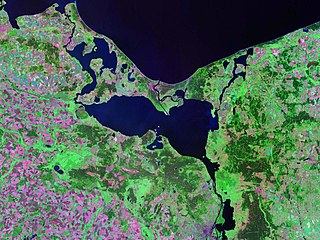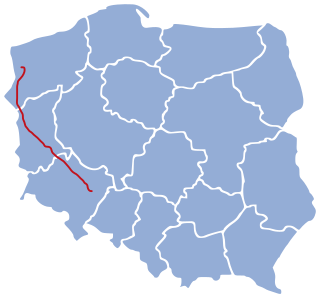
Gdynia is a city in northern Poland and a seaport on the Baltic Sea coast. With an estimated population of 260 000, it is the 12th-largest city in Poland and the second-largest in the Pomeranian Voivodeship after Gdańsk. Gdynia is part of a conurbation with the spa town of Sopot, the city of Gdańsk, and suburban communities, which together form a metropolitan area called the Tricity (Trójmiasto) with around one million inhabitants.
Transport in Poland involves air, water, road and rail transportation. The country has a large network of municipal public transport, such as buses, trams and the metro. As a country located at the 'cross-roads' of Europe, Poland is a nation with a large and increasingly modern network of transport infrastructure.

Pomerania is a historical region on the southern shore of the Baltic Sea in Central Europe, split between Poland and Germany. The central and eastern part belongs to the West Pomeranian, Pomeranian and Kuyavian-Pomeranian voivodeships of Poland, while the western part belongs to the German states of Mecklenburg-Western Pomerania and Brandenburg.

Szczecin is the capital and largest city of the West Pomeranian Voivodeship in northwestern Poland. Located near the Baltic Sea and the German border, it is a major seaport and Poland's seventh-largest city. As of 31 December 2022, the population was 391,566.

The West Pomeranian Voivodeship, also known as the West Pomerania Province, is a voivodeship (province) in northwestern Poland. Its capital and largest city is Szczecin. Its area equals 22 892.48 km2, and in 2021, it was inhabited by 1,682,003 people.

Świnoujście is a city in Western Pomerania and seaport on the Baltic Sea and Szczecin Lagoon, located in the extreme north-west of Poland. Situated mainly on the islands of Usedom and Wolin, it also occupies smaller islands. The largest is Karsibór island, once part of Usedom, now separated by the Piast Canal dug in the late 19th century to facilitate ship access to Szczecin.

Police is a town in the West Pomeranian Voivodeship, in northwestern Poland. It is the capital of Police County and one of the biggest towns of the Szczecin agglomeration.

Goleniów is a town in Pomerania, northwestern Poland with 22,844 inhabitants (2011). It is the capital of Goleniów County in West Pomeranian Voivodeship. The town's area is 12.5 square kilometres (4.8 sq mi), and its geographical position is 53°33'N, 14°49'E. It is situated in the centre of Goleniowska Forest on Goleniów Plain, near main roads numbers 3 and 6.
The table below lists the most recent statistics for over a 100 ports of the Baltic Sea which handle notable freight or passenger traffic.

Szczecin Lagoon, also known as Oder Lagoon, and Pomeranian Lagoon, is a lagoon in the Oder estuary, shared by Germany and Poland. It is separated from the Pomeranian Bay of the Baltic Sea by the islands of Usedom and Wolin. The lagoon is subdivided into the Kleines Haff in the West and the Wielki Zalew in the East. An ambiguous historical German name was Frisches Haff, which later exclusively referred to the Vistula Lagoon.

Turzyn is a municipal neighbourhood of the city of Szczecin, Poland situated on the left bank of Oder river, west of the Szczecin Old Town and Middle Town. As of January 2011 it had a population of 20,373.

The History of Szczecin dates back to the 8th century. Throughout its history the city has been part of Poland, Denmark, Sweden and Germany. Since the Middle Ages, it is one of the largest and oldest cities in the historic region of Pomerania, and today, is it the largest city in northwestern Poland.

History of Pomerania (1945–present) covers the history of Pomerania during World War II aftermath, the Communist and since 1989 Democratic era.

The Port of Świnoujście is a Polish seaport in Świnoujście, Poland on the Baltic Sea located at the Świna strait, on Wolin and Usedom islands. The port has a passenger terminal.

The Port of Police is a Polish seaport and deep water harbour in Police, Poland located on the west bank of the Oder River, off the Szczecin Lagoon. It is the fourth-busiest port in the country.

The Oder is a river in Central Europe. It is Poland's second-longest river in total length and third-longest within its borders after the Vistula and Warta. The Oder rises in the Czech Republic and flows 742 kilometres (461 mi) through western Poland, later forming 187 kilometres (116 mi) of the border between Poland and Germany as part of the Oder–Neisse line. The river ultimately flows into the Szczecin Lagoon north of Szczecin and then into three branches that empty into the Bay of Pomerania of the Baltic Sea.
Eric Spiegel was a German government official. From 2 May to 26 May 1945, he briefly served as the high mayor of German district of the Soviet-occupied city of Szczecin.
The following is a timeline of the history of the city of Szczecin, Poland.

The Wrocław–Szczecin railway is 356-kilometer long, double tracked, electrified railway line in Poland, connecting Wrocław with Zielona Góra, Rzepin, Kostrzyn and Szczecin.

The Port of Szczecin-Świnoujście is a Polish seaport complex in cities of Szczecin and Świnoujście, within northwestern part of West Pomeranian Voivodeship, Poland.


















